Pressure in the expansion tank of a gas boiler: norms + how to pump and adjust
A single-circuit or double-circuit gas boiler is the equipment that makes our life in a house or apartment more comfortable. Manufacturers now produce a huge range of gas appliances that differ in power, functionality, as well as the installation method. However, even the most expensive and reliable models can fail. Agree, it is not very pleasant to stay on a winter evening without heat and hot water.
After analyzing the possible causes of breakdowns in gas equipment, we came to the conclusion that most often malfunctions occur because the pressure in the expansion tank of the gas boiler or water heater is incorrectly set. In the article we will understand why an expansion tank is needed, how to independently pump air into it and adjust the optimal pressure.
The content of the article:
What is an expansion tank for?
During heating, the water tends to expand - with increasing temperature, the volume of liquid increases. In the circuit of the heating system, pressure begins to rise, which can destructively affect gas equipment and pipe integrity.
The expansion tank (expanomat) serves as an additional reservoir into which the excess water formed as a result of heating is squeezed out. When the liquid cools and the pressure stabilizes, it returns through the pipes back to the system.
The expansion tank acts as a protective buffer, it extinguishes water hammer, which are constantly formed in the heating system due to the frequent switching on and off of the pump, and also eliminates the possibility of air jams.

There are two different options for the implementation of damping tanks: open and closed types.They differ not only in the design, but also in the method, as well as the installation site. Consider the features of each of these types in more detail.
Open expansion tank
An open tank is mounted at the top of the heating system. Tanks are made of steel. Most often they have a rectangular or cylindrical shape.
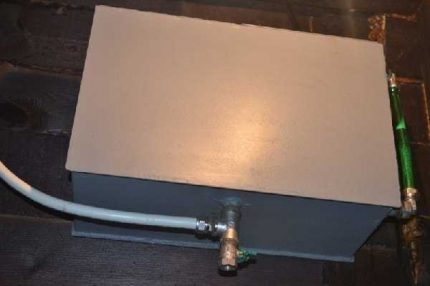
There are several outlets in the open-type tank structure: for water inlet, cooled liquid outlet, control pipe inlet, and also outlet pipe for coolant drainage into the sewer. Read more about the device and types of open tank we wrote in our other article.
Open tank features:
- controls the level of coolant in the heating circuit;
- if the temperature regime has decreased in the system, it compensates for the volume of coolant;
- when the pressure in the system changes, the tank acts as a buffer zone;
- excess coolant is removed from the system into the sewer;
- removes air from the circuit.
Despite the functionality of open expansion tanks, they are almost never used. Since they have many disadvantages, for example, the large size of the tank, the tendency to corrosion. Their installation is carried out in heating systems that work only with natural water circulation.
Closed Expanomat
In closed loop heating systems, an expansion tank of the membrane type is usually mounted, it is optimally suited for any type of gas boiler and has a lot of advantages.
Expansomat is a hermetic container, which in the middle is divided by an elastic membrane. In the first half, excess water will be placed, and in the second - ordinary air or nitrogen.

Membrane expansion tanks can be produced in the form of a hemisphere or in the form of a balloon. Which is quite suitable for use in a heating system with a gas boiler. We recommend that you familiarize yourself with installation features closed tanks.
Advantages of membrane types of tanks:
- ease of self-installation;
- resistance to corrosion;
- work without regular replenishment of the coolant;
- lack of contact of water with the air;
- working capacity under increased load;
- tightness.
Gas attachments are usually equipped with an expansion tank. But the additional tank from the factory is not always configured correctly and can immediately be included in the heating operation.
Air pressure in the expansion tank
The indicator of air or nitrogen pressure in the expansion tank for different gas boilers will not be the same, it all depends on the type of equipment and design features. Standards are indicated by the manufacturer in the product passport.
Typically, the pressure in a new damper tank is 1.5 atm. But such a setting may not be suitable for a specific heating system. Factory settings are easy to reset. For these purposes, in the case of the expansion tank there is a special fitting (for some manufacturers this is a spool for pumping), by means of which the air pressure is adjusted.
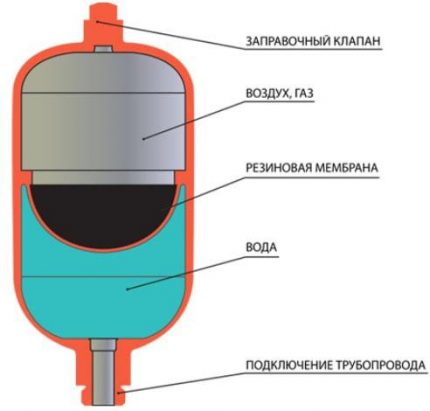
For the normal functioning of the gas boiler, it is necessary that the pressure in the membrane tank is 0.2 atm less than in the system itself. Otherwise, the heated water increased in volume will not be able to enter the tank.
In small houses and apartments for closed heating systems, the pressure in the expansion tank is usually acceptable in the range of 0.8-1.0 bar (atm). But not less than 0.7 bar, since many gas boilers have protection and the device simply will not turn on.
Check the tank pressure level every year. If horse racing is noticed pressure in the heating system, that means, air has come out of the damper tank and it needs to be pumped up.
How to set the optimal pressure?
Pressure gauges are installed on the heating system, with the help of which the pressure in the circuit is controlled. On the very expansion tank there is no fitting for installing the measuring device. But there is a nipple or spool for the release and pumping of air or gas. The nipple is the same as on the wheels of cars. Therefore, you can check the pressure level and adjust it using a conventional car pump with a pressure gauge.

Before releasing excess pressure or pumping air into the expansion tank of a domestic gas boiler, it is necessary to prepare the system. The automobile pressure gauge shows the value in MPa, the obtained data must be converted to atmospheres or bars: 1 Bar (1 atm) = 0.1 MPa.
Pressure Measurement Algorithm:
- Turn off the gas boiler. Wait until the water stops circulating through the system.
- In the area with the hydraulic tank, close all shut-off valves and drain the coolant through the drain fitting. For boilers with a built-in tank, the return line is shut off, as well as the water supply.
- Connect the pump to the tank nipple.
- Inflate air to indicators of 1.5 atm. Wait a bit for the remnants of water to pour out, let air in again.
- Close the valves of the stop valves and compressor to pump up the pressure to the parameters specified in the passport or to the level - pressure in the system minus 0.2 atm. If the tank is pumped, excess air is vented.
- Remove the pump from the nipple, screw on the cap and close the drain fitting. Pour water into the system.
You can check the correct adjustment of the air pressure when the boiler reaches the operating parameters.

If the air pressure in the expansion tank is incorrectly set, the entire heating system may malfunction. If the expancer is pumped, the compensating properties will not work. Since air will push the excess hot water out of the tank, increasing the pressure in the pipes of the heating system.
And with low pressure readings of the compensating capacity, the water will simply push through the membrane and fill the entire tank. As a result, when the temperature of the coolant rises, a safety valve will operate.
Sometimes in double-circuit gas boilers fuses are triggered even if the pressure of the built-in expansion tank is set correctly. This indicates that the tank volume is too small for such a heating system. In this situation, it is recommended to mount an additional hydraulic tank.
Purpose of an additional tank of a double-circuit boiler
As a rule, the built-in compensation tanks in gas boilers have a volume of about 6-8 liters. They are designed to compensate for the expansion of 120 liters of coolant circulating in the heating system. Under normal operating conditions, such an expansion tank is enough for a small apartment or house.

If the heating area is large, installed warm floor or many radiators in rooms, the volume of the standard built-in capacity will be small, since more water is used.
When heated, excess coolant completely fills the tank.And since there is no free space in the tank, the water pressure increases in the heating system itself and an emergency discharge occurs safety valve. After that, a gas boiler is unlikely to automatically turn on.
To avoid such negative consequences, an additional expansion tank with a membrane in the design for a double-circuit gas boiler is installed in the heating system. When the standard tank is completely full, the water will go into the reserve hydraulic tank. After cooling, the liquid returns to the radiators.
Calculation of the volume of the expansion tank
It is not difficult to ensure stable operation of the heating system; the main thing is to choose the right volume of the compensation tank. Calculation of the volume of the exchanger should be made taking into account the most intensive operation mode of the gas boiler. At the first starts of heating, the air temperature is still not very low, so the equipment will work with an average load. With the advent of frost, the water warms up more and its amount increases, requiring more additional space.

You can independently calculate the exact capacity of the expansion tank. To do this, first determine the amount of coolant in the entire heating system.
Methods for calculating the volume of water in the heating system:
- Completely drain the coolant from the pipes into buckets or another container so that the volume can be calculated.
- Pour water into the pipes through the water meter.
- The volumes are summarized: boiler capacity, amount of liquid in radiators and pipes.
- Calculation of the boiler power - the installed boiler power is multiplied by 15. That is, for a 25 kW boiler, 375 liters of water (25 * 15) will be needed.
After the amount of coolant is calculated (example: 25 kW * 15 = 375 liters of water), the volume of the expansion tank is calculated.
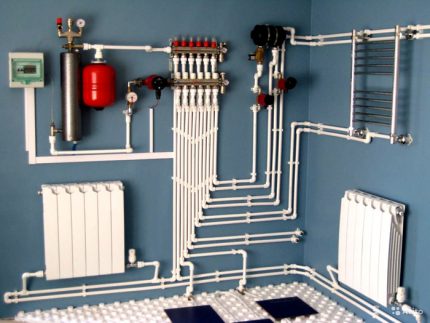
The calculation methods are quite complex. For single-story houses, use the following formula:
Expansion tank volume = (V * E) / D,
Where
- D - an indicator of the effectiveness of the tank;
- E - liquid expansion coefficient (for water - 0.0359);
- V - the amount of water in the system.
The tank efficiency indicator is obtained by the formula:
D = (Pmax — Ps) / (Pmax +1),
Where
- Ps= 0.5 bar is an indicator of the charging pressure of the expansion tank;
- Pmax - maximum pressure of the heating system, an average of 2.5 bar.
- D= (2,5-0,5)/(2,5 +1)=0,57.
For a system with a boiler power of 25 kW, an expansion tank with a volume of: (375 * 0.0359) /0.57 = 23.61 l is required.
And although the dual-circuit gas boiler already has a built-in tank of 6-8 liters, but looking at the calculation results, we understand that there will be no stable functioning of the heating system without installing an additional expansion tank.
Conclusions and useful video on the topic
You can learn how to independently calculate the volume of a hydraulic tank and adjust its pressure by viewing the videos below.
Easy way to determine the volume of the expansion tank:
Instructions for self-adjustment of the pressure level in the expansion tank:
Gas boilers must necessarily be equipped with expansion tanks. They “absorb” excess heat transfer resulting from heating and prevent the formation of air jams. In double-circuit types of equipment, such devices are mounted, but often their volume is insufficient for the trouble-free functioning of heating.
Compensation tanks should be selected based on the pressure and volume of the coolant in the system. It is important to properly configure the tank, otherwise it will not be able to ensure uninterrupted and stable operation of the gas boiler.
Still have questions about pumping and adjusting the pressure in the expansion tank? Ask him in the comments section - our experts and other visitors to the site will try to help you.

 Installation and connection of an expansion tank in open and closed versions of heating systems
Installation and connection of an expansion tank in open and closed versions of heating systems  Expansion tank for closed heating: operating principle and device + how to choose and install in the system
Expansion tank for closed heating: operating principle and device + how to choose and install in the system  Heating from an electric boiler: options for organizing heating based on an electric boiler
Heating from an electric boiler: options for organizing heating based on an electric boiler 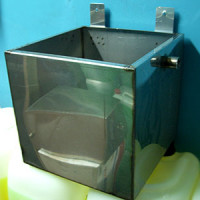 Expansion tank for open heating: device, purpose, main types + tips for calculating the tank
Expansion tank for open heating: device, purpose, main types + tips for calculating the tank 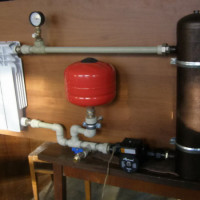 Expansion tank of the heating system: device, calculation and selection of the best option
Expansion tank of the heating system: device, calculation and selection of the best option  Installation of a circulation pump: types, purpose and features of its installation
Installation of a circulation pump: types, purpose and features of its installation  How much does it cost to connect gas to a private house: the price of organizing gas supply
How much does it cost to connect gas to a private house: the price of organizing gas supply  The best washing machines with dryer: model rating and customer tips
The best washing machines with dryer: model rating and customer tips  What is the color temperature of light and the nuances of choosing the temperature of the lamps to suit your needs
What is the color temperature of light and the nuances of choosing the temperature of the lamps to suit your needs  Replacement of a geyser in an apartment: replacement paperwork + basic norms and requirements
Replacement of a geyser in an apartment: replacement paperwork + basic norms and requirements